Experimental Comparison of Heating Emitters in Mediterranean Climate
Abstract
:1. Thermal Comfort: Indoor Plant Emitters and Control Strategies
2. Study Proposal and Methodological Approach
3. Experimental Activity: Set-Up
3.1. Brief Description for Test-Room
3.2. Set-Up of Experimental Equipment
- 21 December 2017–03 January 2018 with baseboard heating;
- 20 January 2018–02 February 2018 with fan-coil units;
- 03 January 2018–16 February 2018 with radiant heating floor.
4. Results
4.1. Comfort Conditions Analysis
4.1.1. Monitoring for Selected Winter Days
4.1.2. Operative Temperature and Relative Humidity Analysis
4.2. Air Temperature Distribution
4.2.1. Air Temperature Field
4.2.2. Asymmetry of Air Temperature
5. Discussion
6. Conclusions
Author Contributions
Funding
Institutional Review Board Statement
Informed Consent Statement
Data Availability Statement
Conflicts of Interest
References
- ASHRAE Fundamentals. Thermal comfort. In ASHRAE Handbook; American Society of Heating, Refrigerating and Air Conditioning Engineers: Atlanta, GA, USA, 2017. [Google Scholar]
- ASHRAE Thermal Environmental Conditions for Human Occupancy Standard 55; American Society of Heating, Refrigerating and Air Conditioning Engineers: Atlanta, GA, USA, 2013.
- Parsons, K.C. Environmental ergonomics: A review of principles, methods and models. Appl. Ergon. 2000, 31, 581–594. [Google Scholar] [CrossRef]
- Liu, J.; Yao, R.; McCloy, R. A method to weight three categories of adaptive thermal comfort. Energy Build. 2012, 47, 312–320. [Google Scholar] [CrossRef]
- International Standardization Organization. ISO 7730—Ergonomics of the Thermal Environment—Analytical Determination and Interpretation of Thermal Comfort Using Calculation of the PMV and PPD Indices and Local Thermal Comfort; ISO: Geneva, Switzerland, 2005. [Google Scholar]
- Alfano, F.R.A.; Olesen, B.W.; Palella, B.I.; Riccio, G. Thermal comfort: Design and assessment for energy saving. Energy Build. 2014, 81, 326–336. [Google Scholar] [CrossRef]
- Ferrantelli, A.; Võsa, K.; Kurnitski, J. Optimization of radiators, underfloor and ceiling heater towards the definition of a reference ideal heater for energy efficient buildings. Appl. Sci. 2018, 8, 2477. [Google Scholar] [CrossRef] [Green Version]
- Gorni, D.; Visioli, A. Genetic algorithms based reference signal determination for temperature control of residential buildings. Appl. Sci. 2018, 8, 2129. [Google Scholar] [CrossRef] [Green Version]
- Gendelis, S.; Jakovics, A.; Ratnieks, J. Thermal comfort condition assessment in test buildings with different heating/cooling systems and wall envelopes. Energy Proced. 2017, 132, 153–158. [Google Scholar] [CrossRef]
- Lin, B.; Wang, Z.; Sun, H.; Zhu, Y.; Ouyang, Q. Evaluation and comparison of thermal comfort of convective and radiant heating terminals in office buildings. Build. Environ. 2016, 106, 91–102. [Google Scholar] [CrossRef]
- Da Silva Júnior, A.; Mendonça, K.C.; Vilain, R.; Pereira, M.L.; Mendes, N. On the development of a simplified model for thermal comfort control of split systems. Build. Environ. 2020, 179, 106931. [Google Scholar] [CrossRef]
- Han, Y.; Li, Z.; Xu, P. Comparative study on energy consumption of gas-fired infrared radiant and convection heating. Adv. Mater. Res. 2014, 953, 849–853. [Google Scholar] [CrossRef]
- Karmann, C.; Schiavon, S.; Graham, L.T.; Raftery, P.; Bauman, F. Comparing temperature and acoustic satisfaction in 60 radiant and all-air buildings. Build. Environ. 2017, 126, 431–441. [Google Scholar] [CrossRef] [Green Version]
- Zeiler, W.; Boxem, G. Effects of thermal activated building systems in schools on thermal comfort in winter. Build. Environ. 2009, 44, 2308–2317. [Google Scholar] [CrossRef]
- Inard, C.; Meslem, A.; Depecker, P. Energy consumption and thermal comfort in dwelling-cells: A zonal-model approach. Build. Environ. 1998, 33, 279–291. [Google Scholar] [CrossRef]
- Petráš, D.; Kalús, S. Effect of thermal comfort/discomfort due to infrared heaters installed at workplaces in industrial buildings. Indoor Built Environ. 2000, 9, 148–156. [Google Scholar] [CrossRef]
- Ghaddar, N.; Salam, M.; Ghali, K. Steady thermal comfort by radiant heat transfer: The impact of the heater position. Heat Transf. Eng. 2006, 27, 29–40. [Google Scholar] [CrossRef]
- Léger, J.; Rousse, D.R.; Le Borgne, K.; Lassue, S. Comparing electric heating systems at equal thermal comfort: An experimental investigation. Build. Environ. 2018, 128, 161–169. [Google Scholar] [CrossRef]
- Tye-Gingras, M.; Gosselin, L. Comfort and energy consumption of hydronic heating radiant ceilings and walls based on cfd analysis. Build. Environ. 2012, 54, 1–13. [Google Scholar] [CrossRef]
- Sevilgen, G.; Kilic, M. Numerical analysis of air flow, heat transfer, moisture transport and thermal comfort in a room heated by two-panel radiators. Energy Build. 2011, 43, 137–146. [Google Scholar] [CrossRef]
- Halawa, E.; van Hoof, J.; Soebarto, V. The impacts of the thermal radiation field on thermal comfort, energy consumption and control A critical overview. Renew. Sustain. Energy Rev. 2014, 37, 907–918. [Google Scholar] [CrossRef]
- Catalina, T.; Virgone, J.; Kuznik, F. Evaluation of thermal comfort using combined CFD and experimentation study in a test room equipped with a cooling ceiling. Build. Environ. 2009, 44, 1740–1750. [Google Scholar] [CrossRef]
- Kitagawa, K.; Komoda, N.; Hayano, H.; Tanabe, S. Effect of humidity and small air movement on thermal comfort under a radiant cooling ceiling by subjective experiments. Energy Build. 1999, 30, 185–193. [Google Scholar] [CrossRef]
- Corgnati, S.P.; Perino, M.; Fracastoro, G.V.; Nielsen, P.V. Experimental and numerical analysis of air and radiant cooling systems in offices. Build. Environ. 2009, 44, 801–806. [Google Scholar] [CrossRef]
- Causone, F.; Baldin, F.; Olesen, B.W.; Corgnati, S.P. Floor heating and cooling combined with displacement ventilation: Possibilities and limitations. Energy Build. 2010, 42, 2338–2352. [Google Scholar] [CrossRef]
- Bagheri, N.; Moosavi, A.; Safii, M.B. Thermal enhancement of baseboard heaters using novel fin-tube arrays: Experiment and simulation. Int. J. Therm. Sc. 2020, 151, 106285. [Google Scholar] [CrossRef]
- Shobi, M.O.; Salarian, H.; Nichkoohi, A.L.; Nimvari, M.E. Experimental and numerical investigations of a modified designed baseboard radiator using an air gap enhancing free convection heat transfer. J. Build. Eng. 2020, 32, 101535. [Google Scholar] [CrossRef]
- Karmann, C.; Stefano, S.; Bauman, F. Thermal comfort in buildings using radiant vs. all-air systems: A critical literature review. Build. Environ. 2017, 111, 123–131. [Google Scholar] [CrossRef] [Green Version]
- Sun, H.; Yang, Z.; Lin, B.; Shi, W.; Zhu, Y.; Zhao, H. Comparison of thermal comfort between convective heating and radiant heating terminals in a winter thermal environment: A field and experimental study. Energy Build. 2020, 224, 110239. [Google Scholar] [CrossRef]
- Lin, C.; Liu, H.; Tseng, K.; Lin, S. Heating, Ventilation, and air conditioning system optimization control strategy involving fan coil unit temperature control. Appl. Sci. 2019, 9, 2391. [Google Scholar] [CrossRef] [Green Version]
- Sánchez-García, D.; Bienvenido-Huertas, D.; Pulido-Arcas, J.A.; Rubio-Bellido, C. Analysis of energy consumption in different European cities: The Adaptive Comfort Control Implemented Model (ACCIM) considering Representative Concentration Pathways (RCP) scenarios. Appl. Sci. 2020, 10, 1513. [Google Scholar] [CrossRef] [Green Version]
- Date, J.; Athienitis, A.K.; Fournier, M. A study of temperature set point strategies for peak power reduction in residential buildings. Energy Proced. 2015, 78, 2130–2135. [Google Scholar] [CrossRef] [Green Version]
- Wang, Z.; de Dear, R.; Lin, B.; Zhu, Y.; Ouyang, Q. Rational selection of heating temperature set points for China’s hot summer e Cold winter climatic region. Build. Environ. 2015, 93, 63–70. [Google Scholar] [CrossRef]
- Moon, J.W.; Han, S.H. Thermostat strategies impact on energy consumption in residential buildings. Energy Build. 2011, 43, 338–346. [Google Scholar] [CrossRef]
- Ghahramani, A.; Zhang, K.; Dutta, K.; Yang, Z.; Becerik-Gerber, B. Energy savings from temperature set-points and deadband: Quantifying the influence of building and system properties on savings. Appl. Energy 2016, 165, 930–942. [Google Scholar] [CrossRef] [Green Version]
- Bienvenido-Huertas, D.; Sánchez-García, D.; Rubio-Bellido, C.; Pulido-Arcas, J.A. Influence of the improvement in thermal expectation levels with adaptive set-point temperatures on energy consumption. Appl. Sci. 2020, 10, 5282. [Google Scholar] [CrossRef]
- Christensen, J.E.; Chasapis, K.; Gazovic, L.; Kolarik, J. Indoor environment and energy consumption optimization using field measurements and building energy simulation. Energy Proced. 2015, 78, 2118–2123. [Google Scholar] [CrossRef] [Green Version]
- Hang, L.; Kim, D. Enhanced model-based predictive control system based on fuzzy logic for maintaining thermal Comfort in IoT Smart Space. Appl. Sci. 2018, 8, 1031. [Google Scholar] [CrossRef] [Green Version]
- Tushar, W.; Wang, T.; Lan, L.; Xu, Y.; Withanage, C.; Yuen, C.; Wood, K.L. Policy design for controlling set-point temperature of ACs in shared spaces of buildings. Energy Build. 2017, 134, 105–114. [Google Scholar] [CrossRef] [Green Version]
- Wang, F.; Chen, Z.; Feng, Q.; Zhao, Q.; Cheng, Z.; Guo, Z.; Zhong, Z. Experimental comparison between set-point based and satisfaction based indoor thermal environment control. Energy Build. 2016, 128, 686–696. [Google Scholar] [CrossRef]
- Nikdel, L.; Janoyan, K.; Bird, S.D.; Powers, S.E. Multiple perspectives of the value of occupancy-based HVAC control systems. Build. Environ. 2018, 129, 15–25. [Google Scholar] [CrossRef]
- Yongchao, Z.; Honnekeri, A.; Pigman, M.; Fountain, M.; Zhang, H.; Xiang, Z.; Arens, E. Use of adaptive control and its effects on human comfort in a naturally ventilated office in Alameda, California. Energy Build. 2019, 203, 109435. [Google Scholar]
- Aftab, M.; Chen, C.; Chau, C.; Rahwan, T. Automatic HVAC control with real-time occupancy recognition and simulation-guided model predictive control in low-cost embedded system. Energy Build. 2017, 154, 141–156. [Google Scholar] [CrossRef] [Green Version]
- Ascione, F.; De Masi, R.F.; de Rossi, F.; Ruggiero, S.; Vanoli, G.P. MATRIX, a multi activity test-room for evaluating the energy performances of ‘building/HVAC’ systems in Mediterranean climate: Experimental set-up and CFD/BPS numerical modelling. Energ. Buildings 2016, 126, 424–446. [Google Scholar] [CrossRef]
- Zhou, X.; Liu, Y.; Luo, M.; Zhang, L.; Zhang, Q.; Zhang, X. Thermal comfort under radiant asymmetries of floor cooling system in 2 h and 8 h exposure durations. Energ. Build. 2019, 188–189, 98–100. [Google Scholar] [CrossRef] [Green Version]
- Fanger, P.O.; Banhidi, L.; Olesen, B.W.; Langkilde, G.L. Comfort limits for heated ceilings. ASHRAE Trans. 1980, 86, 141–156. [Google Scholar]
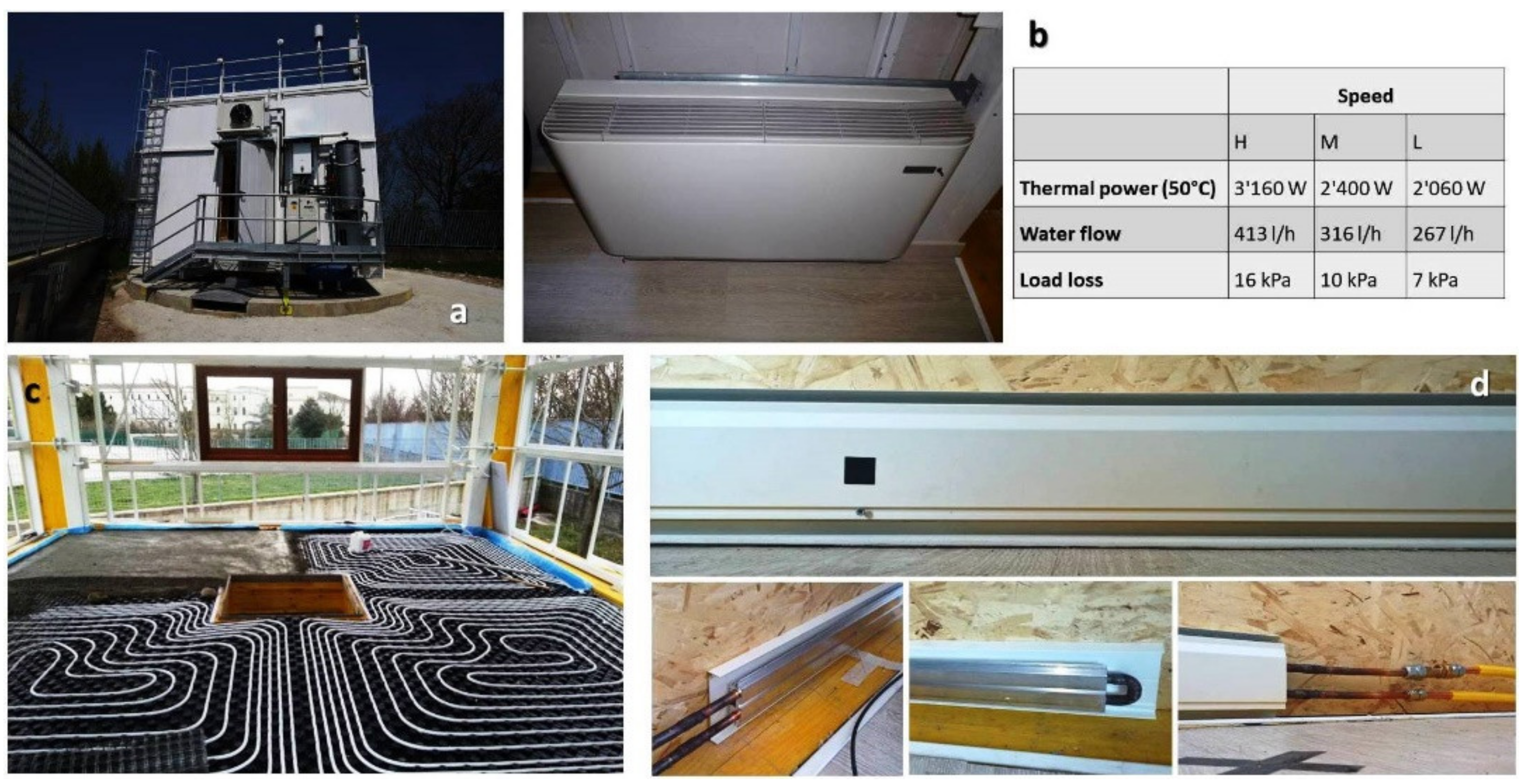
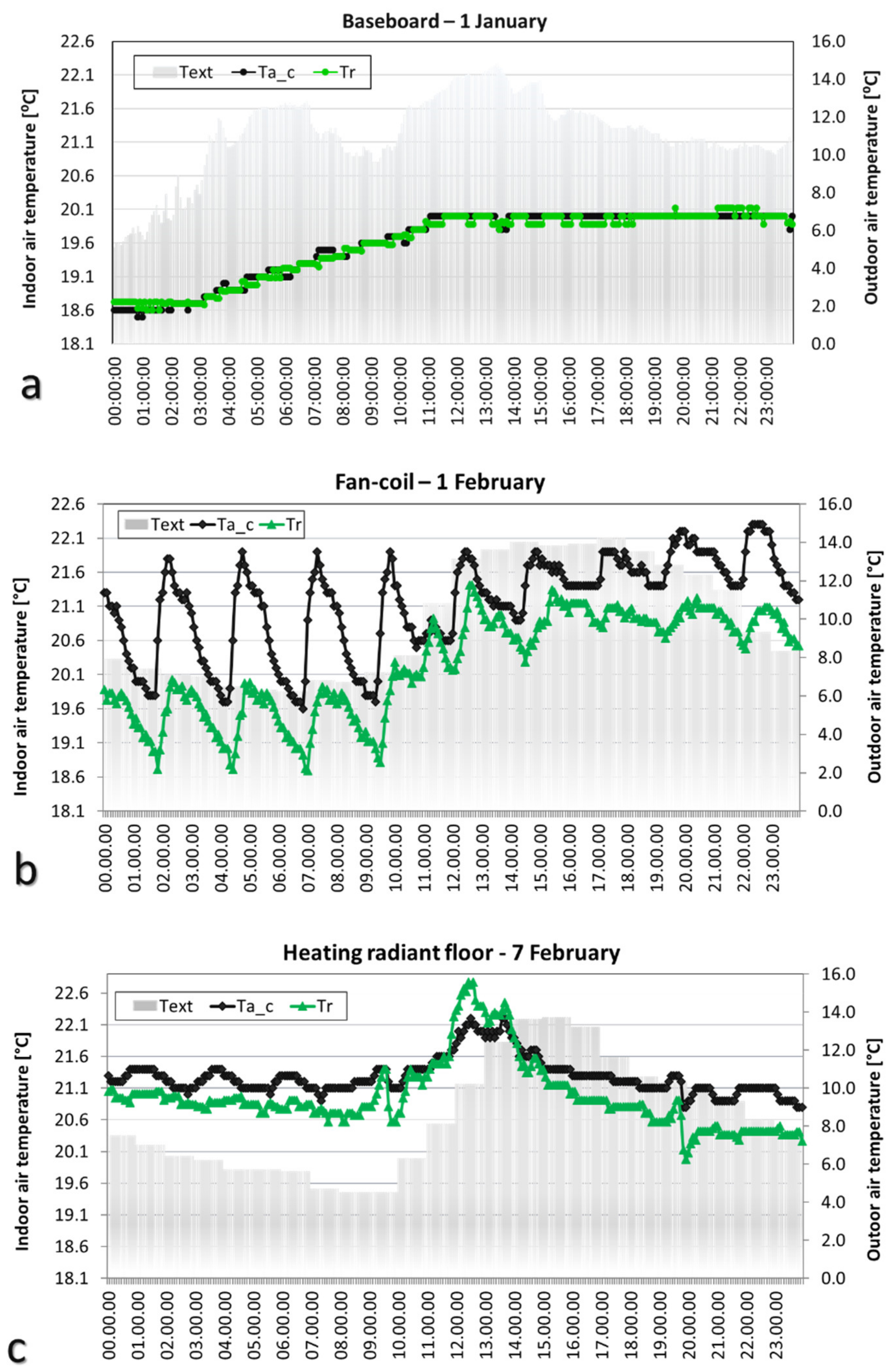



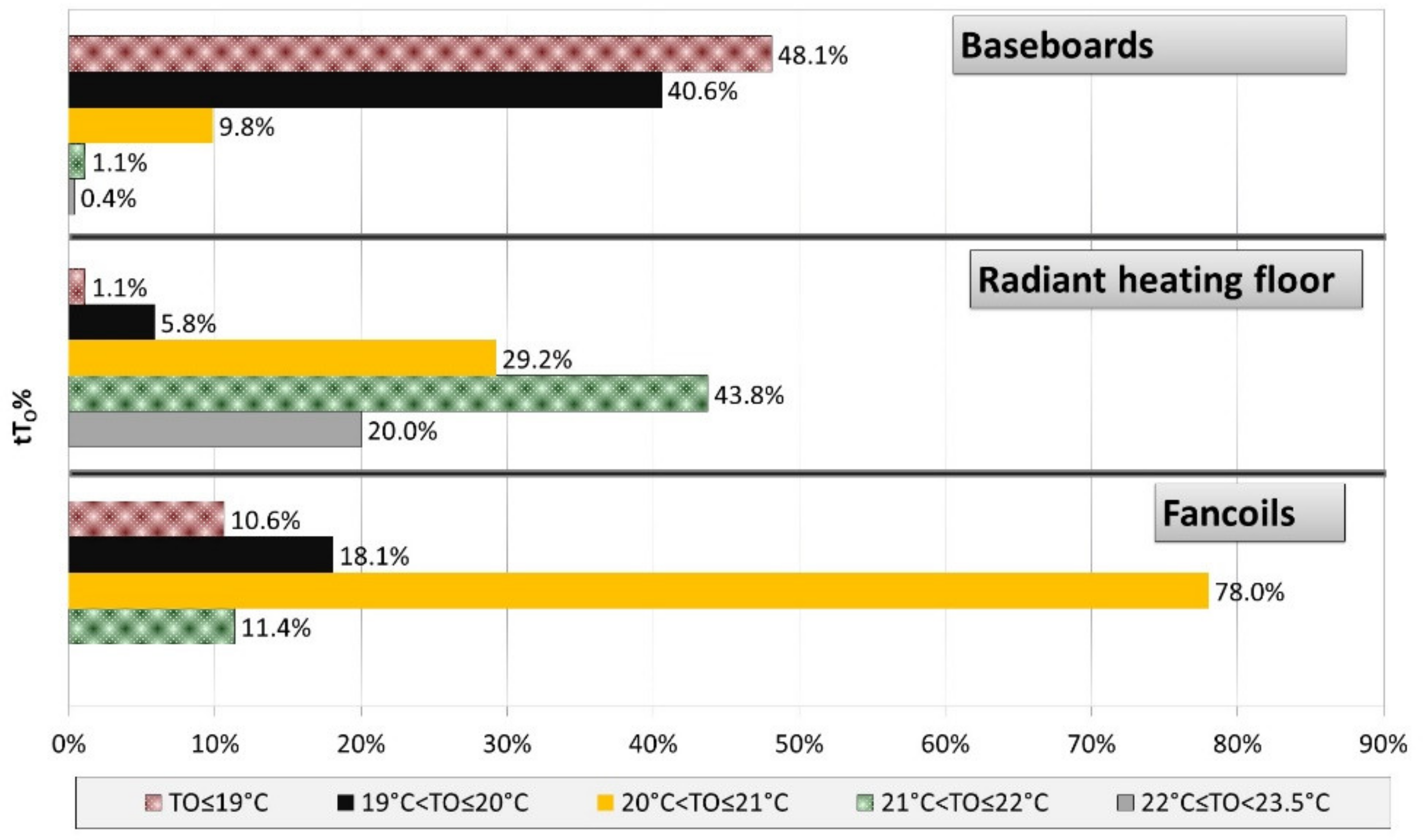

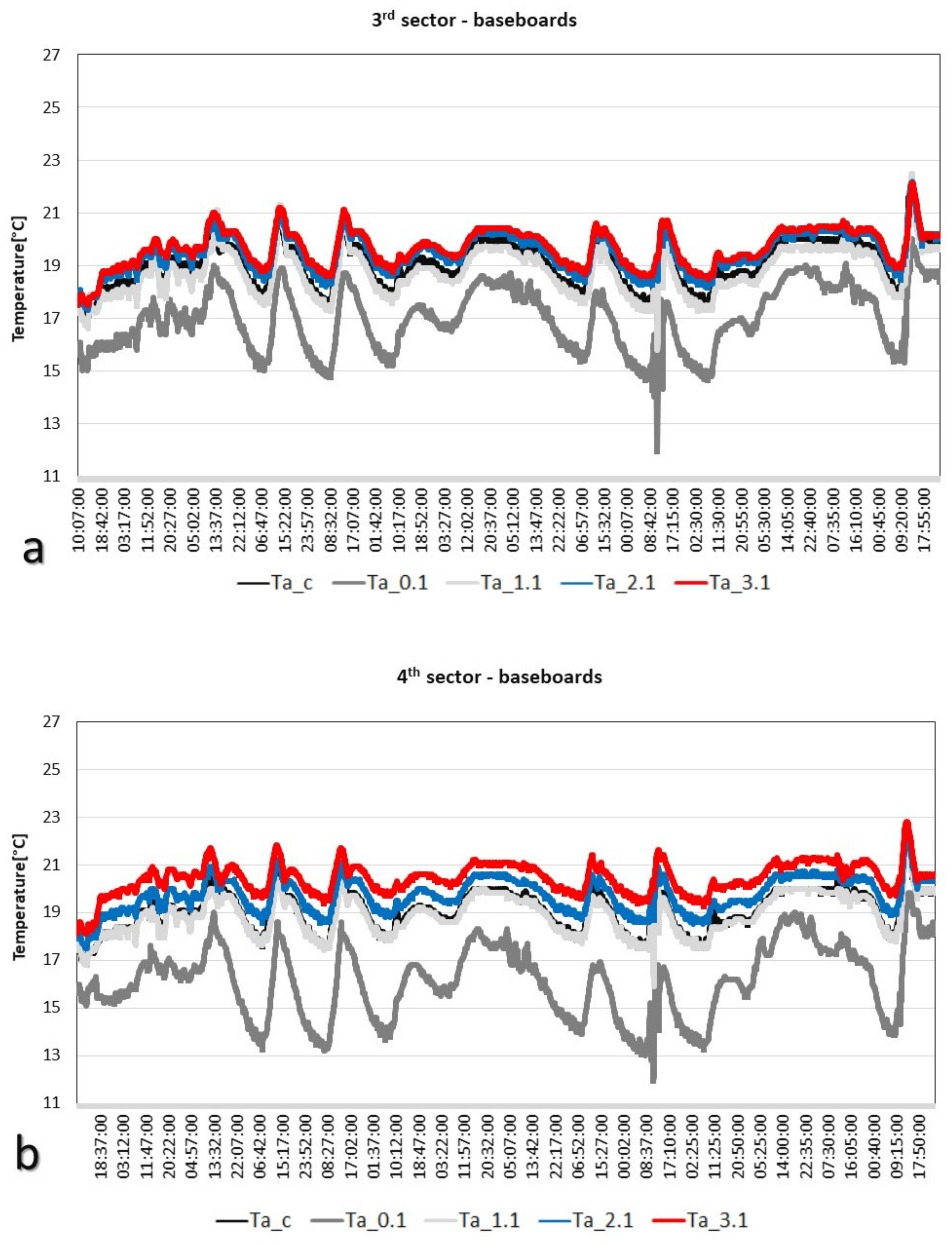

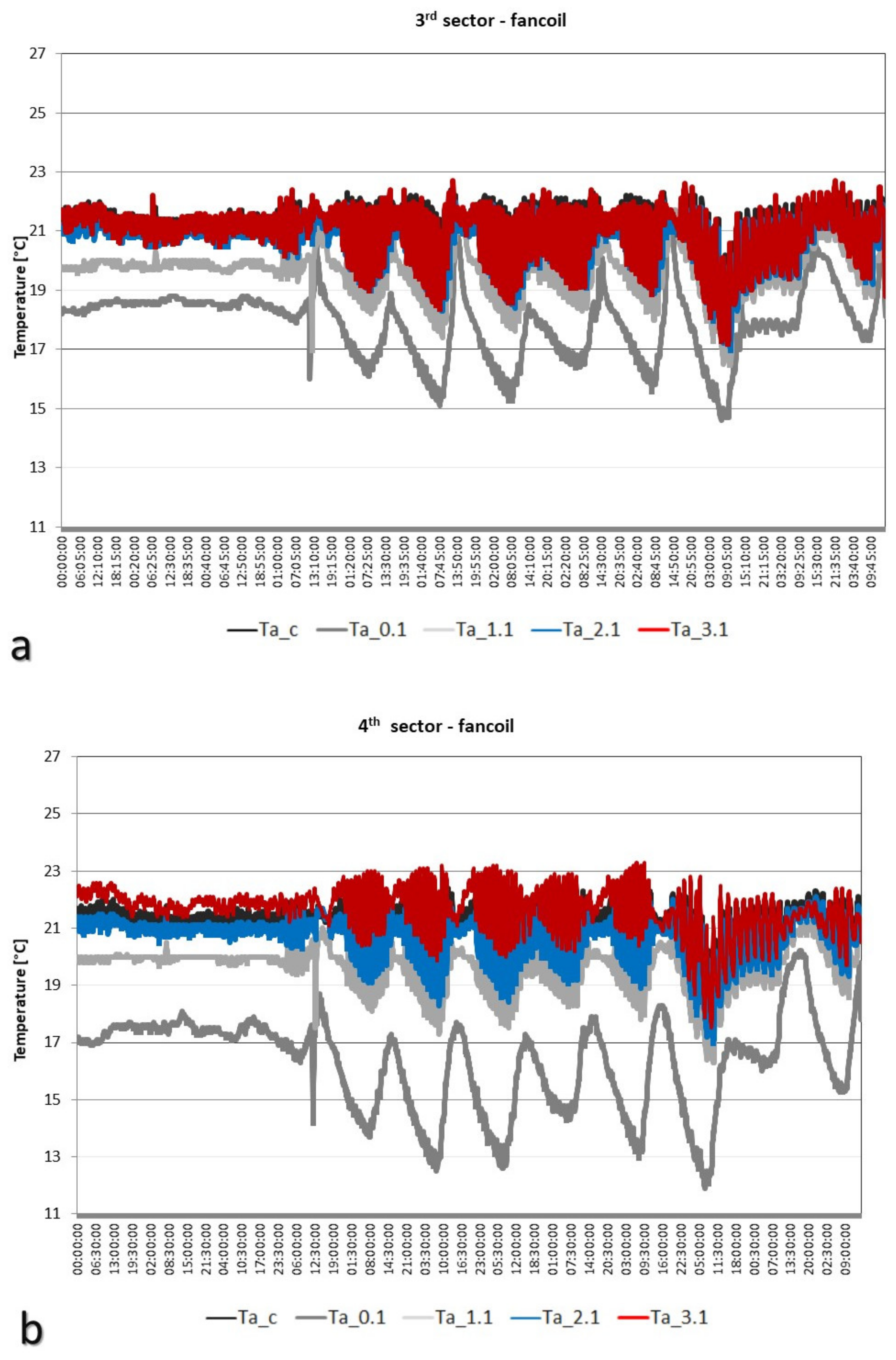
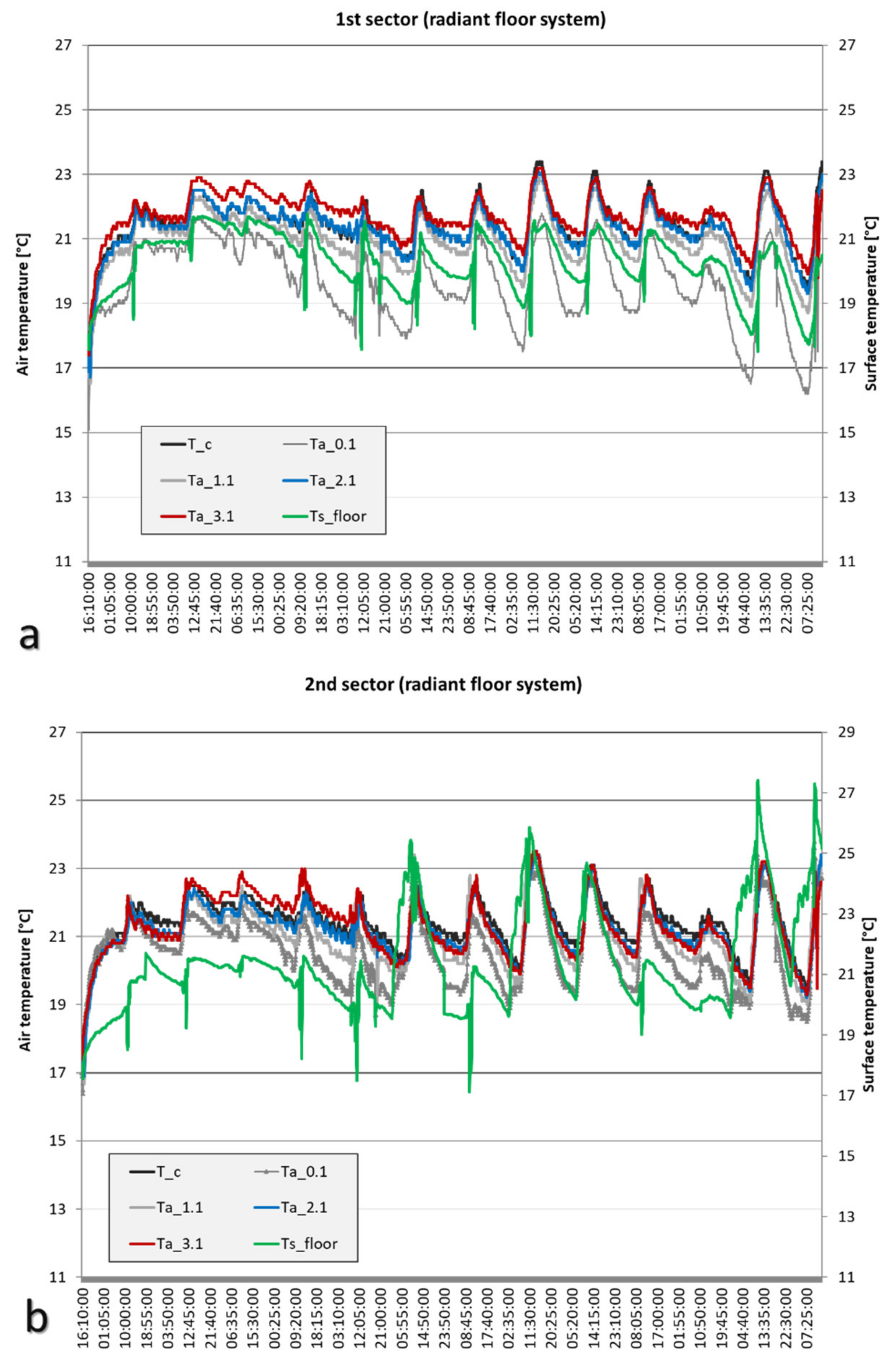

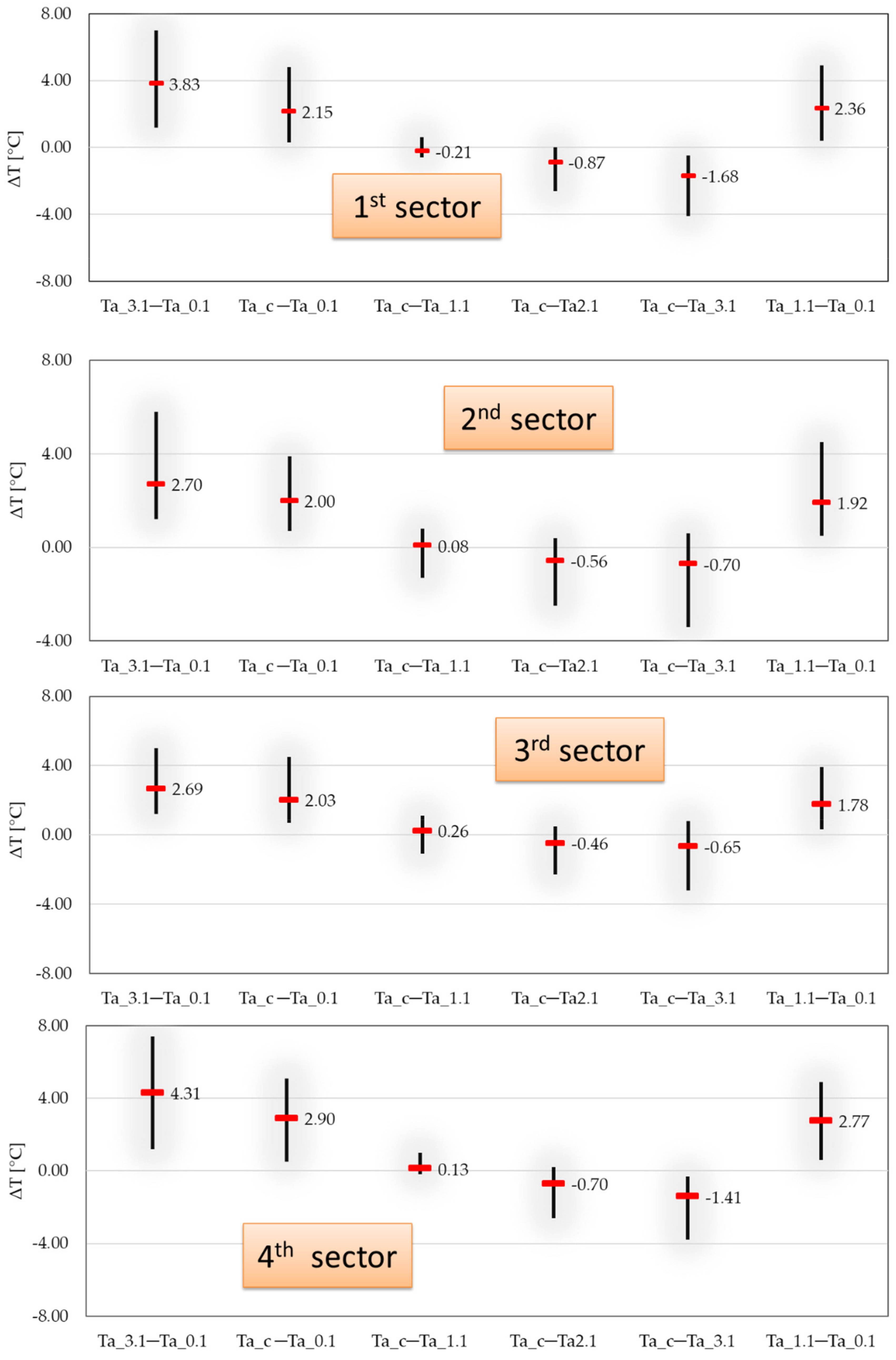

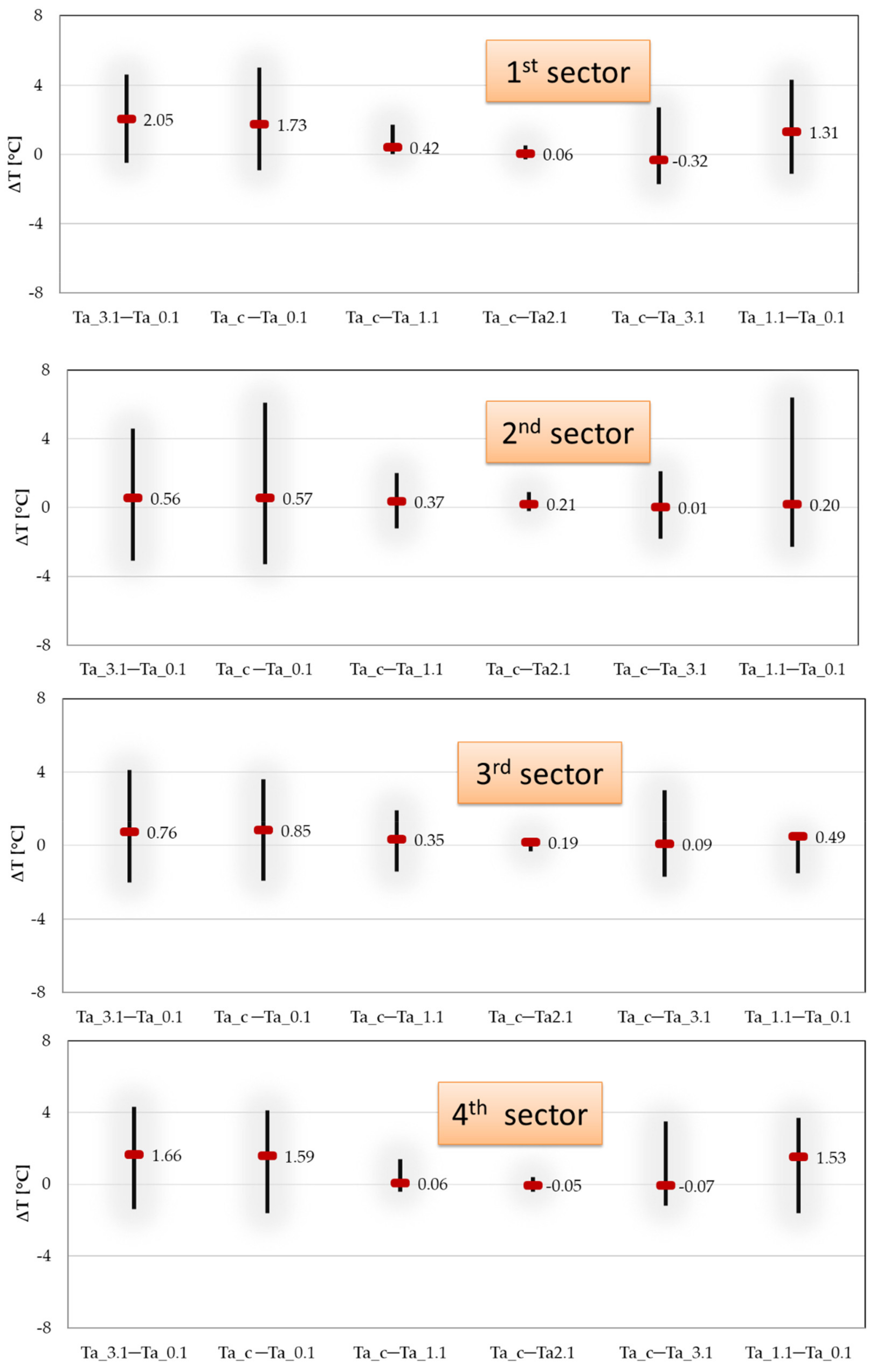
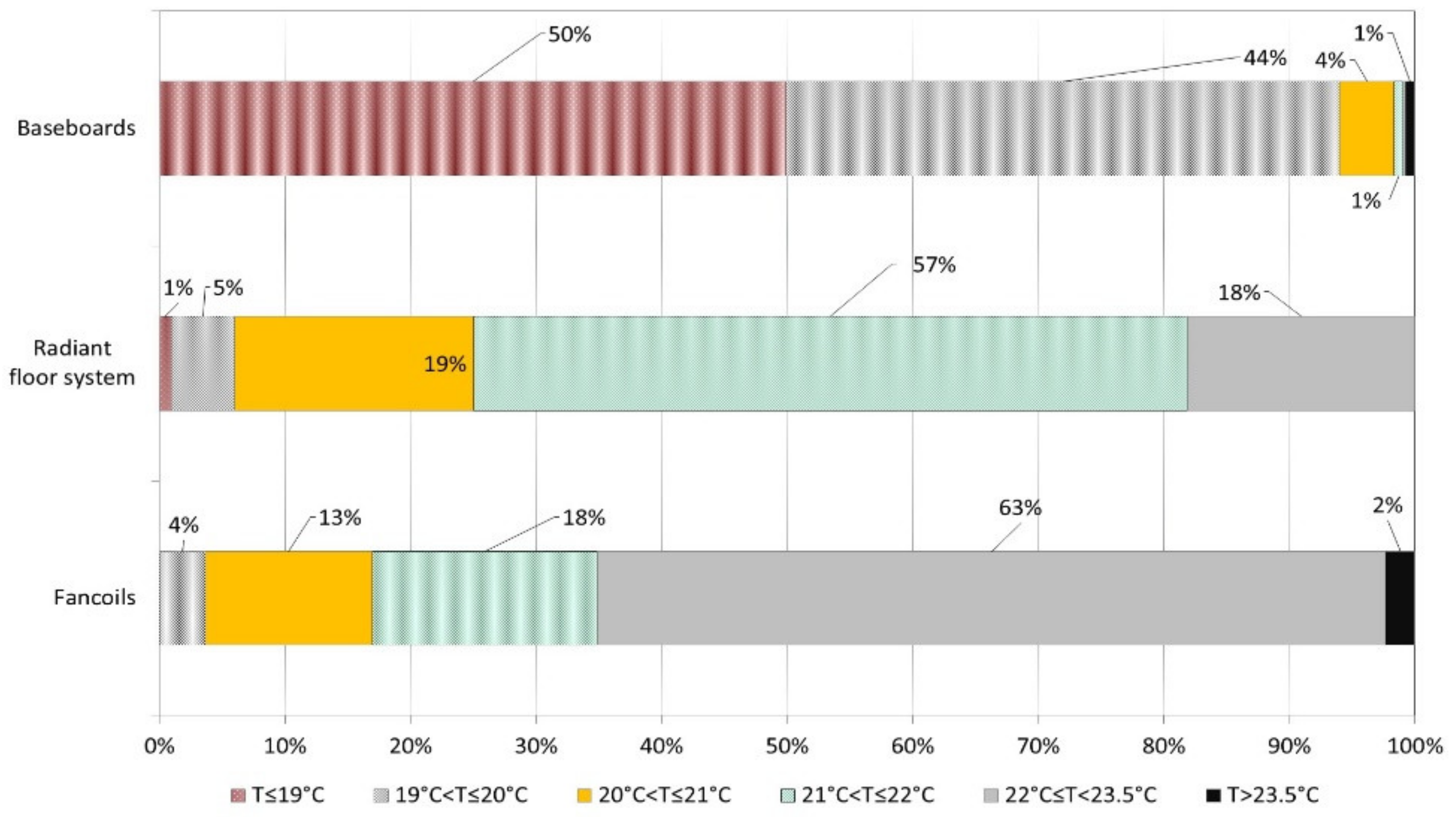
| Global Comfort | Local Discomfort | ||||||||
|---|---|---|---|---|---|---|---|---|---|
| PMV | PPD (%) | Tf (°C) | DR (%) | ∆Tpr,wc (°C) | ∆Tpr,cc (°C) | ∆Tpr,ww (°C) | ∆Tpr,cw (°C) | Ta,1.1 − Ta,0.1 (°C) | |
| A | −0.20 to 0.20 | <6 | 19–29 | <10 | <5 | <14 | <23 | <10 | <2 |
| B | −0.50 to 0.50 | <10 | 19–29 | <20 | <5 | <14 | <23 | <10 | <3 |
| C | −0.70 to 0.70 | <15 | 17–31 | <30 | <7 | <18 | <35 | <13 | <4 |
| Sensor | Type | Model | Range | Accuracy |
|---|---|---|---|---|
| Rain Gauge | Cylindrical body of 400 cm3 | NESA-ANS-PL400-N | 0 ÷ 300 mm/h | ±2% |
| Wind speed | Ultrasonic anemometer | DELTA OHM HD52.3D | 0 ÷ 60 m/s | ±2% |
| Wind direction | Ultrasonic anemometer | 0 ÷ 359.9° | ±2° RMSE 1.0 m/s | |
| Air temperature | Pt100 | −40 ÷ 60 °C | ±0.1% | |
| Relative humidity | Capacitive transducer | 0 ÷ 100% | ±1.5% RH at 15 ÷ 35 °C | |
| Atmospheric pressure | Piezoresistive transducer | 600 ÷ 1100 hPa | ±0.5 hPa at 20 °C | |
| Global solar radiation | Class II thermopile pyranometer | 0 ÷ 2000 W/m2 | <10% day−1 |
| Measure | Sensor | Range | Accuracy | Response Time |
|---|---|---|---|---|
| Temperature | PT-100 NESA | −40 ÷ 80 °C | 0.015 °C | <60 s |
| Relative humidity | PT-100 NESA | 0 ÷ 100% | 0.1% | <60 s |
| Temperature | PT-100 TESTO | −20 ÷ 70 °C | 0.1 °C | <60 s |
| Relative humidity | PT-100 TESTO | 0 ÷ 100% | 0.1% | <60 s |
| Surface temperature | Thin-flowmeter | ≥205 °C | ±0.8 °C | 0.20 s |
| Air speed | Anemometer | 0.1–30 m/s | 0.1 m/s | <60 s |
| Mean radiant temperature | Globe thermometer | −40 ÷ +60 °C | 0.01 °C | <10 s |
| 1 January | 1 February | 7 February | |||||||
|---|---|---|---|---|---|---|---|---|---|
| Max | Min | Mean | Max | Min | Mean | Max | Min | Mean | |
| Temperature (°C) | 14.8 | 5.1 | 9.8 | 14.5 | 5.7 | 9.9 | 14.5 | 4.1 | 8.5 |
| Global solar radiation (W/m2) | 602 | 12 | 220 | 583 | 10 | 218 | 750 | 25 | 208 |
| Relative humidity (%) | 100 | 59 | 79.2 | 100 | 58 | 81,5 | 99 | 49 | 80.5 |
Publisher’s Note: MDPI stays neutral with regard to jurisdictional claims in published maps and institutional affiliations. |
© 2021 by the authors. Licensee MDPI, Basel, Switzerland. This article is an open access article distributed under the terms and conditions of the Creative Commons Attribution (CC BY) license (https://creativecommons.org/licenses/by/4.0/).
Share and Cite
Masi, R.F.D.; Ruggiero, S.; Vanoli, G.P. Experimental Comparison of Heating Emitters in Mediterranean Climate. Appl. Sci. 2021, 11, 5462. https://doi.org/10.3390/app11125462
Masi RFD, Ruggiero S, Vanoli GP. Experimental Comparison of Heating Emitters in Mediterranean Climate. Applied Sciences. 2021; 11(12):5462. https://doi.org/10.3390/app11125462
Chicago/Turabian StyleMasi, Rosa Francesca De, Silvia Ruggiero, and Giuseppe Peter Vanoli. 2021. "Experimental Comparison of Heating Emitters in Mediterranean Climate" Applied Sciences 11, no. 12: 5462. https://doi.org/10.3390/app11125462
APA StyleMasi, R. F. D., Ruggiero, S., & Vanoli, G. P. (2021). Experimental Comparison of Heating Emitters in Mediterranean Climate. Applied Sciences, 11(12), 5462. https://doi.org/10.3390/app11125462








